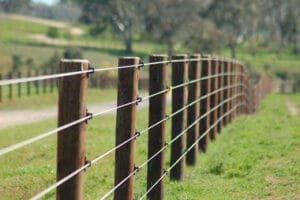Choosing the right fencing for your property can be just as challenging, and with as many overwhelming options to consider, as when choosing the right horse. The market is flooded with so many choices these days, from traditional wooden post and rail fences, to pre-fabricated ‘flexi’ fences, and electric fences.
Some of the most important things to remember when choosing the right fence for your property, is to:
- Make sure that your fences are visible;
- Make sure there are no sharp or abrasive edges that can cause harm to your horses; and
- Are well maintained to ensure they stay this way.
So, how do we know which is the best fencing choice, and how do we maintain them so that they stay safe for our horses? Firstly, each property is as unique as the horses and people on it. Choosing the right fence depends on your needs, the horses that you keep, and your budget. A breeding property for instance would need much higher fencing for stallions and possibly a diamond link mesh to stop foals from slipping through fences.
Below we will run through some of the options available, what they are, the pros and cons, and the maintenance routines for some of the more common and popular options.
Traditional Wooden Post and Rail
Post and rail fences are simply beautiful. They are a safe option and help minimise risks of horse injury, are durable and difficult for those escape artists to get out of.
Most of us have dreamed of owning paddocks lined in pristine white lines of fencing, just like in the movies. However, the reality of owning a post and rail fence can be a little different to how they are depicted in cinema. Yes, they are beautiful and a safe fencing choice, however they also require a fair amount of maintenance which must be considered when making your choice.
Post and rail fences will need to be painted or treated (it’s important to be sure this is a non-toxic product) for weatherproofing and to stop horses from chewing. Once painted or treated, this then needs to be checked on a regular basis to make sure that there is no peeling.
Overall, a wooden post and rail is a sturdy and highly visible fence, but can be expensive both to install and maintain, as well as the heavy time cost in maintenance.
Pre-Fabricated Fencing
There are many varieties of pre-fabricated fencing on the market. These usually resemble the traditional post and rail fencing and are made from plastics and/or metal and are strong. While usually at the top end of the price range, they come with little to no maintenance, are easily installed, safe, and visible.
Many properties have taken to this option as the higher cost can usually be justified by the little to no maintenance costs.

Post and Wire
A post and wire fence is usually a budget-friendly option for horse owners. Wooden or metal post (star pickets should be capped to avoid sharp edges) and a high tensile wire (not barbed), usually 4/5 strands, strung between them. Mesh link is also growing in popularity and is safer than the standard strung wire fence, though it is important to choose a mesh that is small enough so that if a horse kicks out, they can’t get a hoof stuck and injure themselves.
Wire fencing can be tricky as the strands of wire are not all that visible and horses don’t always see them in time, especially in the wet. In saying that, it depends on your horse. Some horses, for the most part, have a good respect for fencing and will be aware of their surroundings.

Electric Fencing
Electric fencing is one of the most well-known and with good reason. It is cost-effective and as long as you keep your system well-maintained, it is a safe option for most horses. It is versatile and can be used for a range of different situations from running a buffer fence on the inside of existing fences to stop horses from hanging over the fence and to setting up temporary fencing at competitions or for strip grazing.
Electric fence tape can come in a range of bright and highly visible colours and most horses will stay well away from it once they have touched it once. In saying that, they do know if you forget to switch it on – so be aware!

Hybrid Fencing
Another option that is becoming more and more common, is blending different fencing mediums to better suit your needs. This could be a diamond link mesh attached to a post and rail fence, a wooden post and top rail with strung wire or timber posts with polymer rails. Most horse owners choose to incorporate electric fencing into the mix as well, for added security and assurance as well as giving longevity to fence life without horses leaning or rubbing on them.
At the end of the day, choosing the right fencing for your property depends largely on your unique circumstances – it doesn’t matter what type of fencing you choose, or what fencing you have so long as it is safe for your horse and your situation. You must remember to inspect fencing regularly for loose wire, periodically test electric fencing for shorts, check for signs of chewing and sharp edges, to keep your horse safe and secure.



